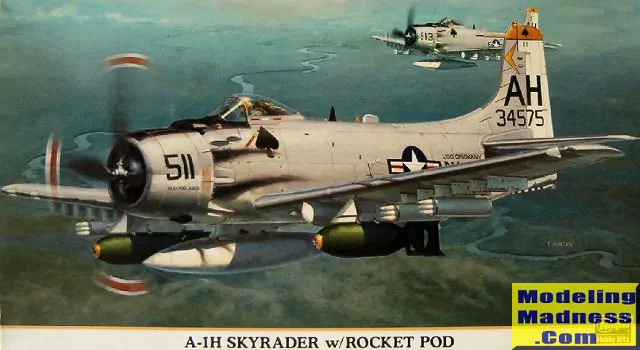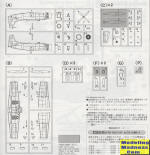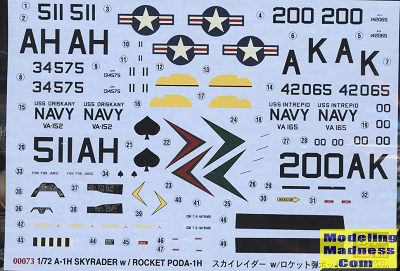
Hasegawa 1/72 A-1H Skyraider w Rocket Pod
| KIT #: | 00073 |
| PRICE: | $25.00 shipped second hand |
| DECALS: | Two options |
| REVIEWER: | Scott Van Aken |
| NOTES: | 2000 limited edition |

| HISTORY |
The Douglas Skyraider, with its straight, low-mounted, tapered wings, was the only aircraft of its time capable of delivering 8,000 pounds of bombs with dive-bombing precision against such difficult targets as mountain bridges and hydroelectric dams. The AD-4B could deliver nuclear bombs using the "toss-bombing" or "over-the-shoulder" bombing technique.
The first AD-1 Skyraider was delivered in 1946 and named according to the Douglas tradition of starting the names of Navy aircraft with "sky." When the Navy, Marine Corps and Air Force numbering systems merged in 1962, the "AD" series Skyraiders were redesignated as "A" series aircraft.
Before production ceased in 1957, 12 years after the airplane was introduced, Douglas built 3,180 Skyraiders in 28 variations. These included carrier- or land-based airplanes, day or night attack bombers, and versions for photographic reconnaissance, electronic countermeasures, airborne early warning, utility and search missions.
Different configurations carried a pilot in an enclosed cockpit, a pilot and another person (either a radar operator or a co-pilot), and a pilot and two other crew. The AD/A-5 could carry a crew of four, plus four passengers or 12 troops, four stretchers, or 2,000 pounds of cargo.
During the Korean conflict, the Skyraiders entered service over the Korean Peninsula in October 1951, and by 1955, there were 29 Navy Skyraider squadrons on carriers.
In 1964, it was modified for service in the Vietnam War, redesignated A-1E/A-1J, and used by the U.S. Navy and the U.S. and South Vietnamese air forces. Because of its ability to carry large bomb loads, absorb heavy ground fire and fly for long periods at low altitude, the Skyraider was particularly suited for close-support missions. The type was also used by the French and some were later sold to Chad.
| THE KIT |
 Dated
2000, this is one of many limited boxings of which Hasegawa is so fond. Despite
the original being over 20 years old, it is still the best in this scale. Previously,
Airfix, Fujimi, and Tsukuda all did the A-1, but this one eclipses those in
terms of detail. It will be interesting to see if Hornby decides to add this one
to its retooled line. Molded in medium grey plastic and up to the usual standard of
Hasegawa with engraved panel lines, and the use of small poly caps to hold in
the prop. The cockpit is adequate with a seat, stick and control panel all
fitting into the cockpit tub. Decals are used for instruments. Judging from what
looks like a canvas cover over the area behind the cockpit, it seems this kit
has the Yankee extraction system, something that I'm pretty sure was was not
used on Navy A-1H Skyraiders.
Dated
2000, this is one of many limited boxings of which Hasegawa is so fond. Despite
the original being over 20 years old, it is still the best in this scale. Previously,
Airfix, Fujimi, and Tsukuda all did the A-1, but this one eclipses those in
terms of detail. It will be interesting to see if Hornby decides to add this one
to its retooled line. Molded in medium grey plastic and up to the usual standard of
Hasegawa with engraved panel lines, and the use of small poly caps to hold in
the prop. The cockpit is adequate with a seat, stick and control panel all
fitting into the cockpit tub. Decals are used for instruments. Judging from what
looks like a canvas cover over the area behind the cockpit, it seems this kit
has the Yankee extraction system, something that I'm pretty sure was was not
used on Navy A-1H Skyraiders.
There is a
nicely detailed engine and the proper engine cover that was spring loaded to be
closed when the engine was not running. This kept salt spray and other crud out.
Once the engine started up, airflow opened these so cooling air could enter. It
also looks like the kit has the right wheels, these being spoked. The usual mass
of weapons pylons are on the bottom of the wing and you have to use them as the
holes are opened up. The kit provided a centerline
and two wing tanks, though you aren't supposed to use the tanks under the wing.
Instead you have two large bombs to fit on those pylons. Along with this are four
seven shot rocket launchers, which justifies the name o f
the boxing.
You'll have to delve into one of the Hasegawa weapons sets if you want to fill
some of the other pylons. As tempting as it is
to fill all the stations, you have to realize that rarely was this done as all
aircraft have to trade carrying capacity (which includes fuel) for range.
f
the boxing.
You'll have to delve into one of the Hasegawa weapons sets if you want to fill
some of the other pylons. As tempting as it is
to fill all the stations, you have to realize that rarely was this done as all
aircraft have to trade carrying capacity (which includes fuel) for range.
Instructions are what one would expect after all these years from Hasegawa. They include Gunze and some FS 595 color references. Markings are for two planes. One is the box art plane from VA-152, while the other is the CAG bird from VA-165. Not sure you'd call either of them very colorful, but it is nice to have the options. Decals are old school with off white whites and will work best with fairly hot water. I should also mention that the yellow markings for VA-152 should be orange, at least according to the box art.
| CONCLUSIONS |
 It
really is a very nice kit and is not all that difficult to build. I built one
back about 6 years ago (see photo) and was quite pleased with the result. Well
worth picking up if you can find one at a reasonable price. This kit does not
get reissued as much as some others so one often has to go to the second hand
kit market to find one.
It
really is a very nice kit and is not all that difficult to build. I built one
back about 6 years ago (see photo) and was quite pleased with the result. Well
worth picking up if you can find one at a reasonable price. This kit does not
get reissued as much as some others so one often has to go to the second hand
kit market to find one.
| REFERENCES |
www.boeing.com
April 2018
Copyright ModelingMadness.com. All rights reserved.
Thanks to me for providing this preview kit for your added education.
If you would like your product reviewed fairly and fairly quickly, please
contact
the editor
or see other details in the
Note to
Contributors.